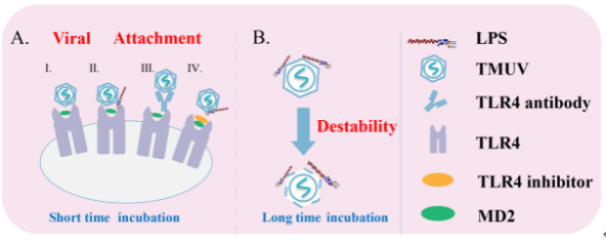Unlike most flaviviruses transmitted by arthropods, Tembusu virus (TMUV) is still active during winter and causes outbreaks in some areas, indicating vector-independent spread of the virus. Gastrointestinal transmission might be one of the possible routes of vector-free transmission, which also means that the virus has to interact with more intestinal bacteria. Here, we found evidence that TMUV indeed can transmit through the digestive tract. Interestingly, using an established TMUV disease model by oral gavage combined with an antibiotic treatment, we revealed that a decrease in intestinal bacteria significantly reduced local TMUV proliferation in the intestine, revealing that the bacterial microbiome is important in TMUV infection. We found that lipopolysaccharide (LPS) present in the outer membrane of Gram-negative bacteria enhanced TMUV proliferation by promoting its attachment. Toll-like receptor 4 (TLR4), a cell surface receptor, can transmit signal from LPS. We confirmed co-localization of TLR4 with TMUV envelope (E) protein as well as their interaction in infected cells. Coherently, TMUV infection of susceptible cells was inhibited by an anti-TLR4 antibody, purified soluble TLR4 protein, and knockdown of TLR4 expression. LPS-enhanced TMUV proliferation could also be blocked by a TLR4 inhibitor. Meanwhile, pre-treatment of duck primary cells with TMUV significantly impaired LPS-induced IL6 production. Collectively, our study provides first insights into vector-free transmission mechanisms of flaviviruses.

Figure 1. Proposed model of TMUV entry into duck primary cells.
The above results were preprinted and published in the Journal of Biological Chemistry, a journal of Nature index, entitled "Toll-like receptor 4 and lipopolysaccharide from commensal microbes regulate Tembusu virus infection" The research has been supported by the Natural Science Foundation of China, the China-Central and Eastern Europe Joint Project, and the Sichuan Provincial Key Project of International Science and Technology Cooperation. Zhen Wu is the first author. Shun Chen and An-chun Cheng are the corresponding authors.

